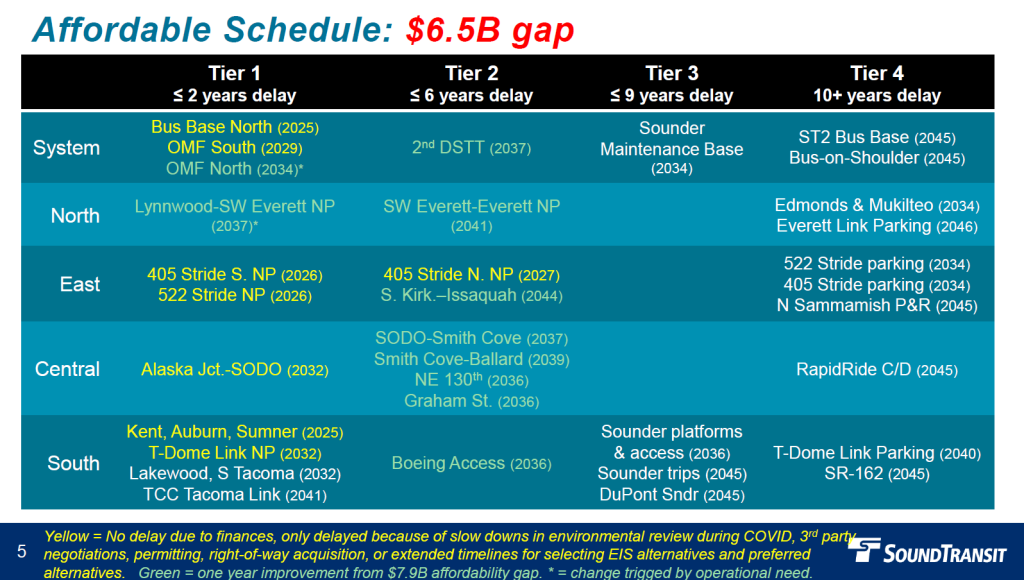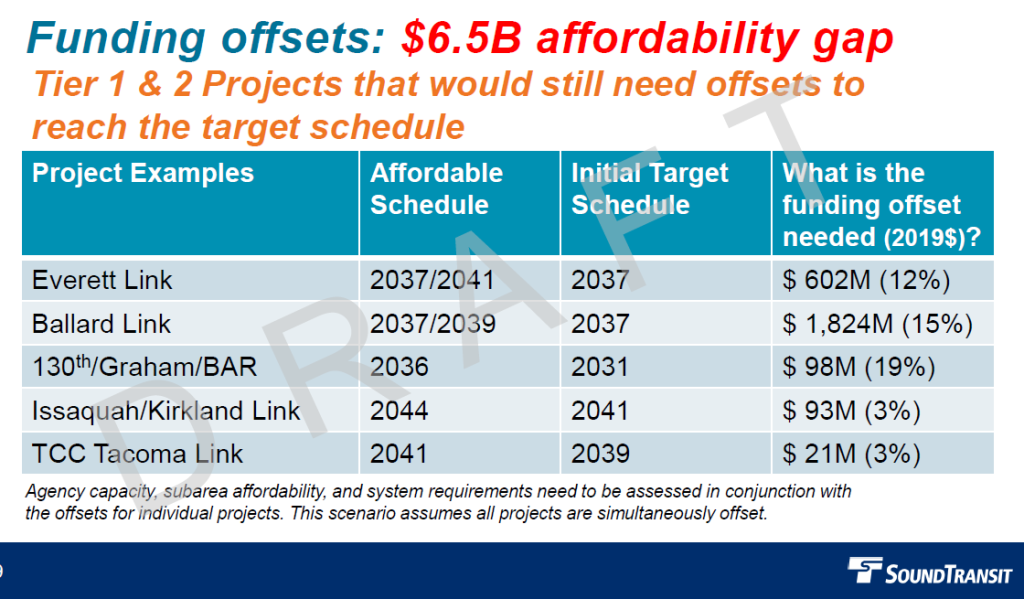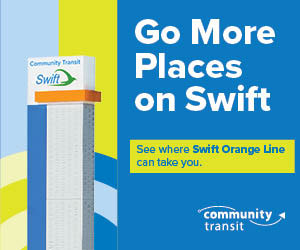SEATTLE, Wash., August 5, 2021 – Today at its Special Business Meeting, the Sound Transit Board adopted to a new realignment plan to address a current $6.5 billion affordability gap down from $7.9 billion earlier this year. The adopted realignment plan will guide the delivery dates for ST2 and ST3 projects not yet in construction.
To view the Sound Transit Board realignment resolution in its entirety, click here.
Projects now under construction, including light rail extensions to Northgate, Lynnwood, Bellevue, Redmond, Federal Way and Tacoma’s Hilltop neighborhood, as well as the Puyallup Sounder garage, are not subject to realignment and are projected to complete on or ahead of schedule. All but the Tacoma Hilltop project are currently trending on or below budget.

In today’s Special Board Meeting held August 5, the adopted realignment strategies have the Lynnwood-Mariner extension to complete 2037 delayed by one year from its original 2036 date, and the Mariner-Everett link delayed five years to 2041. Yet the parking for the Everett link is delayed by 10 years and scheduled to complete in 2046.
To view the realigned capital program original to affordable schedule dates click here.
Also, the $40 million to improve access to the Edmonds and Mukilteo
stations for riders will be delayed by 10 years and scheduled to be completed
in 2034.

These delays can be accelerated but according to today’s presentation, the Mariner-Everett link alone, has a current affordability gap of $602 million.


“We are all in agreement that we want to deliver the Sound Transit 3 package as soon as we can on schedule,” Dave Somers, Snohomish County Executive, shared with the Board at today’s meeting. “We also know that we have a funding gap and an affordability gap, the Board is going to have to face.”
Sound Transit Board Chair and City of University Place Councilmember Kent Keel thank his fellow board members in overcoming the challenges of the last year and to approving the realignment strategy.

“I want to address my deep appreciation to all of you, to the public and to the staff. The citizens of this region expect a lot out of Sound Transit, and I believe transparency is at the top of their list.”
He added, “Now we have a framework before us. This framework with keep the faith with the voters with the plan they approved. It sets target dates and keeps those promises in the forefront of our work.”
Peter Rogoff, Sound Transit CEO shared the complexities of the process and also thanked the Sound Transit Board.

“Realignment is a very complicated area with many legal ramifications. It is not easily described or understood… Thanks to everyone who brought all this together.”
According to a press release, Sound transit attributes the need for the realignment due to a steep rise in real estate and construction costs in the region in combination with advancing environmental review and project designs have driven up cost estimates for future transit expansions, contributing to a $6.5 billion affordability gap.
“In the next three years Sound Transit will nearly triple the length of our light rail system from 22 to 62 miles,” said Chair Keel. “The realignment plan will guide our work to expedite the next waves of projects, including reaching Tacoma, Everett, West Seattle and Ballard and delivering bus rapid transit and Sounder expansions.
“These projects are critical for keeping people moving in the face of our population growth and for protecting our economy and environment. To succeed, we will need expanded collaboration at the local, state and national levels.”
Chair Keel added, “The adopted realignment plan shows what is achievable under our current financial projections, but also sets targets for delivering projects sooner by closing the affordability gap that is identified for each project,” Keel said. “I am grateful for the leadership of System Expansion Committee Chair Claudia Balducci for working with me in developing this hybrid approach.”
Details of the realignment plan, including affordable and target schedules for each project, are available at www.soundtransit.org/realignment.
Establishing Project Tiers
The alignment plan prioritizes voter-approved projects by dividing them into four tiers. Projects in the top two tiers will be managed under the more ambitious completion targets unless or until it becomes necessary to fall back to affordable completion dates that allow more time to generate the required revenues.
Tier 3 and 4 projects will be managed under their affordable schedules unless the program affordability gap is eliminated for Tier 1 and Tier 2 projects, and then shrinks still further to allow Tier 3 and Tier 4 projects to be delivered more quickly.
Expenditures on any one individual project will be managed to protect the affordable schedule for all other projects.
Back in April of this year, Sound Transit launched an online open house and survey that allowed Puget Sound residents to rank their priorities among the voter-approved projects not already under construction and subject to potential realignment decisions. The Sound Transit Board received 9,730 survey responses from the public.
Over 30,000 residents participated in the online open house which shared Sound Transit’s revenue and cost estimate issues related to the purpose of the realignment strategy.
On May 27, the an official report of the survey results were presented to the Sound Transit Board.
Monitoring Economic Forecasts
The realignment process began early in the pandemic as governments around the country braced for significant impacts of a national recession to their revenues. The process continued in early 2021 as Sound Transit updated project cost estimates to reflect market pressures and advancements of project designs.
Realignment deliberations to date have included more than 20 realignment presentations at eight Executive Committee meetings and four System Expansion Committee meetings, three Board workshops, and two special meetings of the Board.
Sound Transit, together with its regional economists, will continue to regularly update financial projections at the same time environmental review and design work continue to update project cost estimates.








